air condition GMC YUKON DENALI 2003 Owners Manual
[x] Cancel search | Manufacturer: GMC, Model Year: 2003, Model line: YUKON DENALI, Model: GMC YUKON DENALI 2003Pages: 447, PDF Size: 21.97 MB
Page 85 of 447
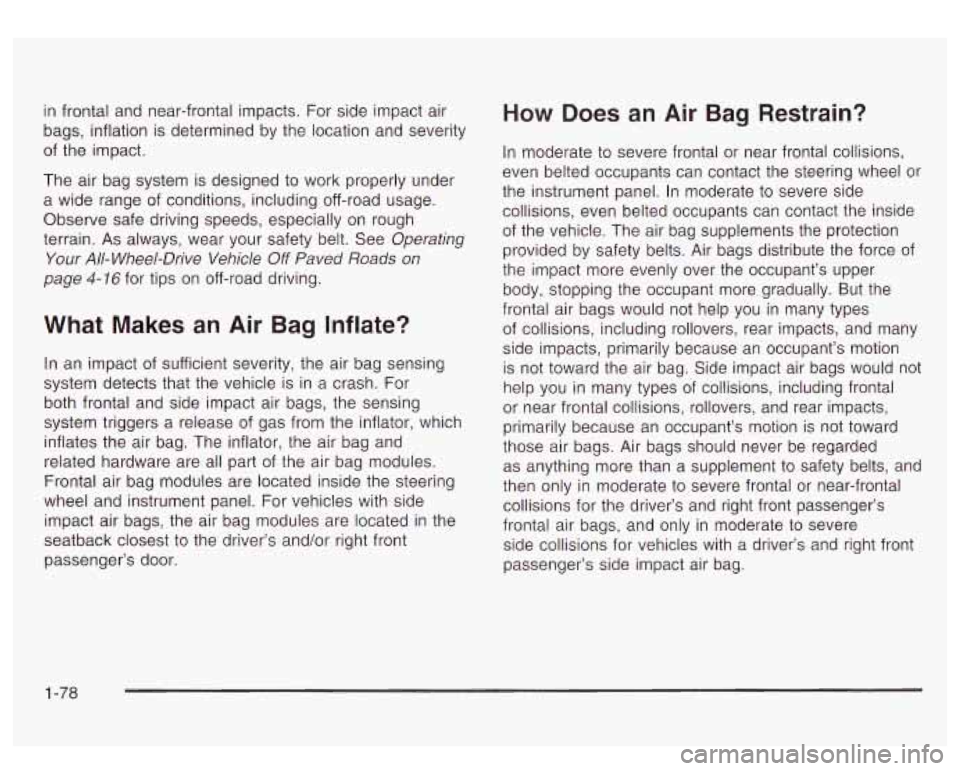
in frontal and near-frontal impacts. For side impact air
bags, inflation is determined by the location and severity
of the impact.
The air bag system is designed to work properly under
a wide range of conditions, including off-road usage.
Observe safe driving speeds, especially on rough
terrain. As always, wear your safety belt. See Operating
Your
All- Wheel-Drive Vehicle Off Paved Roads on
page
4-16 for tips on off-road driving.
What Makes an Air Bag Inflate?
In an impact of sufficient severity, the air bag sensing
system detects that the vehicle is in a crash. For
both frontal and side impact air bags, the sensing
system triggers a release
of gas from the inflator, which
inflates the air bag. The inflator, the air bag and
related hardware are all part of the air bag modules.
Frontal air bag modules are located inside the steering
wheel and instrument panel. For vehicles with side
impact air bags, the air bag modules are located in the
seatback closest
to the driver’s and/or right front
passenger’s door.
How Does an Air Bag Restrain?
In moderate to severe frontal or near frontal collisions,
even belted occupants can contact the steering wheel or
the instrument panel. In moderate
to severe side
collisions, even belted occupants can contact the inside
of the vehicle. The air bag supplements the protection
provided by safety belts. Air bags distribute the force of
the impact more evenly over the occupant’s upper
body, stopping the occupant more gradually. But the
frontal air bags would not help you in many types
of collisions, including rollovers, rear impacts, and many
side impacts, primarily because an occupant’s motion
is not toward the air bag. Side impact air bags would not
help you in many types of collisions, including frontal
or near frontal collisions, rollovers, and rear impacts,
primarily because an occupant’s motion is not toward
those air bags. Air bags should never be regarded
as anything more than a supplement
to safety belts, and
then only in moderate
to severe frontal or near-frontal
collisions for the driver’s and right front passenger’s
frontal air bags, and only in moderate to severe
side collisions for vehicles with a driver’s and right front
passenger’s side impact air bag.
1-78
Page 88 of 447
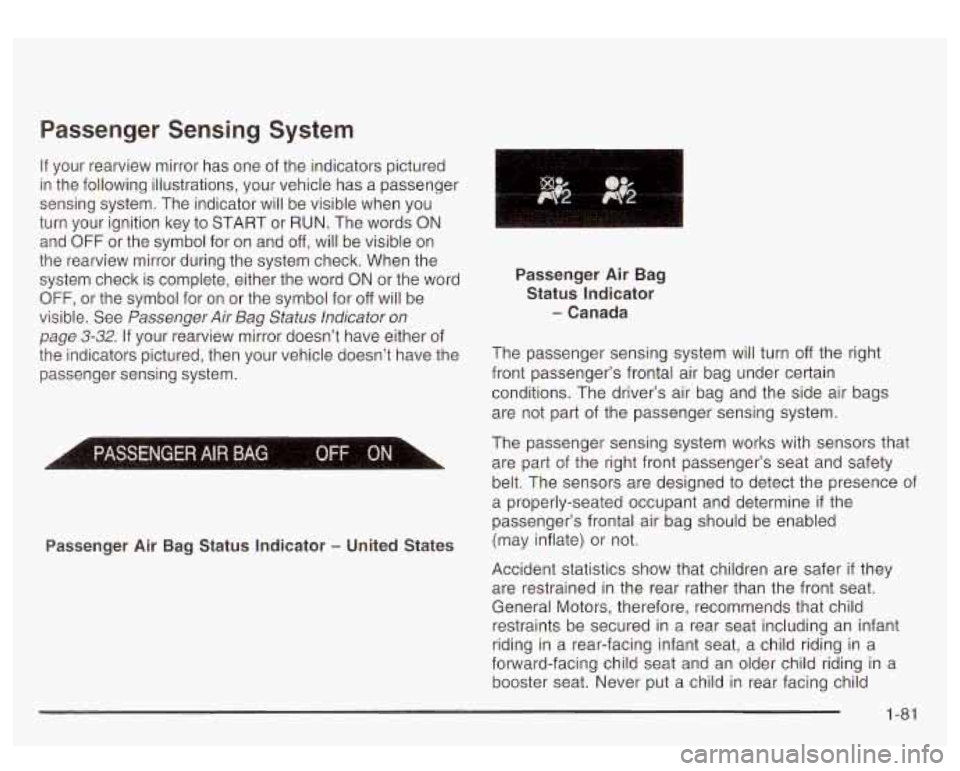
Passenger Sensing System
If your rearview mirror has one of the indicators pictured
in the following illustrations, your vehicle has a passenger
sensing system. The indicator will be visible when you
turn your ignition key
to START or RUN. The words ON
and OFF or the symbol for on and off, will be visible on
the rearview mirror during the system check. When the
system check
is complete, either the word ON or the word
OFF, or the symbol for on or the symbol for off will be
visible. See Passenger
Air Bag Status Indicator on
page 3-32. If your rearview mirror doesn’t have either of
the indicators pictured, then your vehicle doesn’t have the
passenger sensing system.
L
Passenger Air Bag Status Indicator - United States Passenger
Air Bag
Status Indicator
- Canada
The passenger sensing system will turn off the right
front passenger’s frontal air bag under certain
conditions. The driver’s air bag and the side air bags
are not part
of the passenger sensing system.
The passenger sensing system works with sensors that
are part of the right front passenger’s seat and safety
belt. The sensors are designed to detect the presence of
a properly-seated occupant and determine
if the
passenger’s frontal air bag should be enabled
(may inflate) or not.
Accident statistics show that children are safer
if they
are restrained in the rear rather than the front seat.
General Motors, therefore, recommends that child
restraints be secured in a rear seat including an infant
riding in a rear-facing infant seat, a child riding in a
forward-facing child seat and an older child riding in a
booster seat. Never put a child in rear facing child
1-81
Page 131 of 447
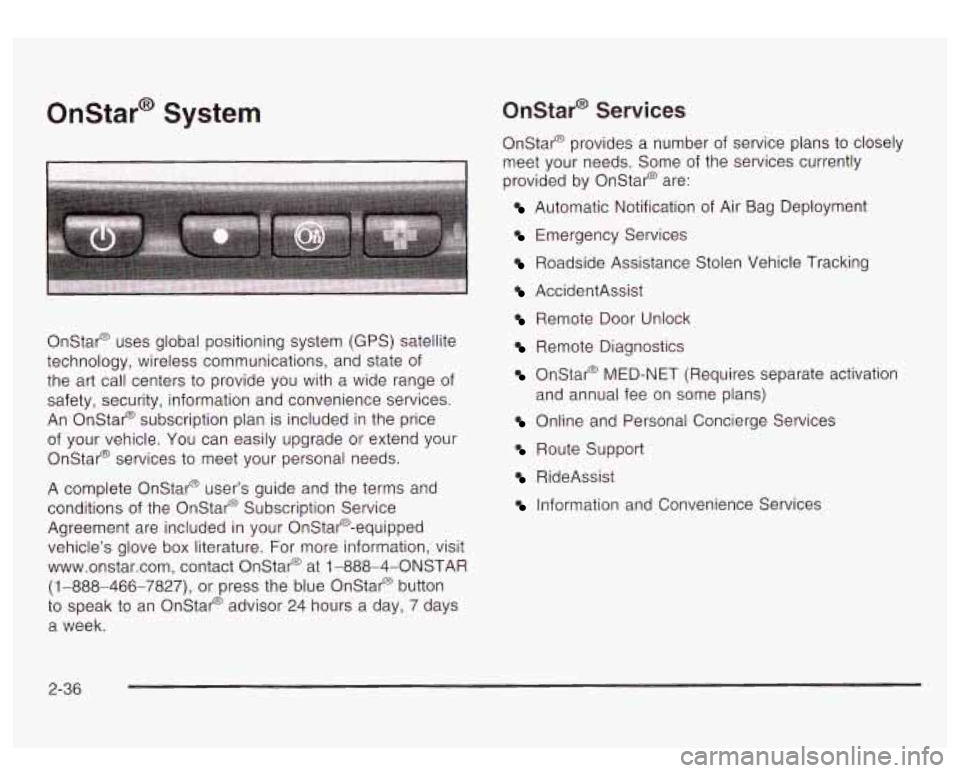
Onstar@ System Onstar@ Services
Onstar@ provides a number of service plans to closely
meet your needs. Some of the services currently
provided by Onstar@ are:
I Automatic Notification of Air Bag Deployment
Onstar@ uses global positioning system (GPS) satellite
technology, wireless communications, and state of
the art call centers
to provide you with a wide range of
safety, security, information and convenience services.
An Onstar@ subscription plan is included in the price
of your vehicle. You can easily upgrade
or extend your
Onstar@ services
to meet your personal needs.
A complete Onstar@ user’s guide and the terms and
conditions
of the Onstar@ Subscription Service
Agreement are included in your Onstar@-equipped
vehicle’s glove box literature. For more information, visit
www.onstar.com, contact Onstar@ at
1 -888-4-ONSTAR
(1 -888-466-7827), or press the blue Onstar@ button
to speak to an Onstar@ advisor 24 hours a day, 7 days
a week.
Emergency Services
Roadside Assistance Stolen Vehicle Tracking
AccidentAssist
Remote Door Unlock
Remote Diagnostics
Onstar@ MED-NET (Requires separate activation
Online and Personal Concierge Services
and annual fee
on some plans)
Route Support
RideAssist
Information and Convenience Services
2-36
Page 163 of 447
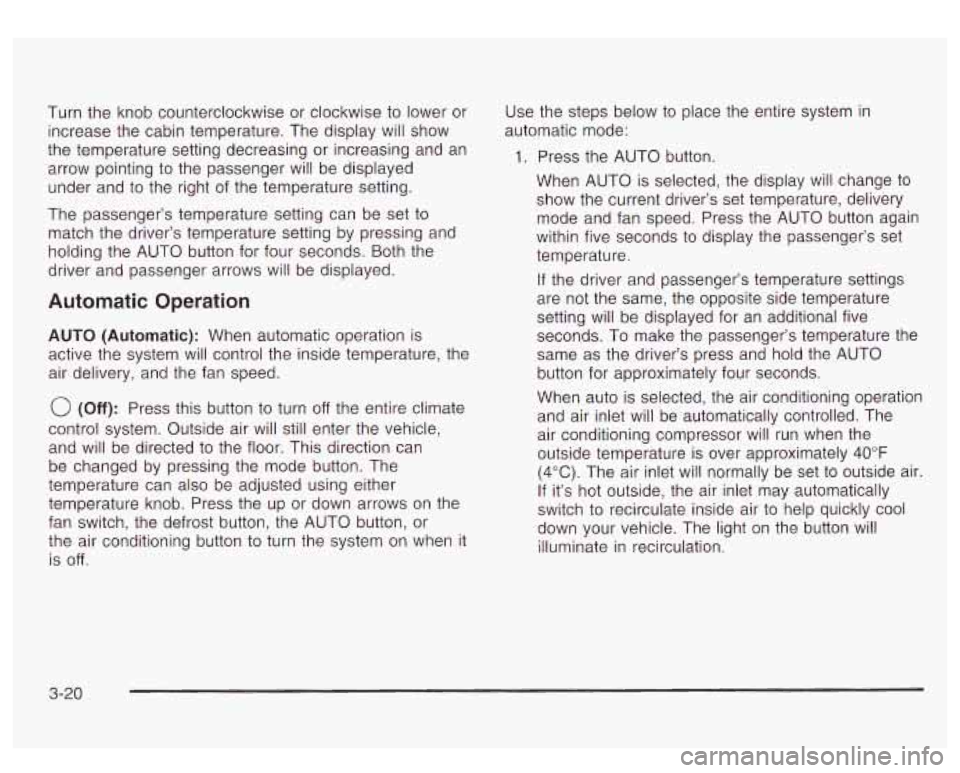
Turn the knob counterclockwise or clockwise to lower or
increase the cabin temperature. The display will show
the temperature setting decreasing or increasing and an
arrow pointing
to the passenger will be displayed
under and
to the right of the temperature setting.
The passenger’s temperature setting can be set
to
match the driver’s temperature setting by pressing and
holding the AUTO button for four seconds. Both the
driver and passenger arrows will be displayed.
Automatic Operation
AUTO (Automatic): When automatic operation is
active the system will control the inside temperature, the
air delivery, and the fan speed.
0 (Off): Press this button to turn off the entire climate
control system. Outside air will still enter the vehicle,
and will be directed
to the floor. This direction can
be changed by pressing the mode button. The
temperature can also be adjusted using either
temperature knob. Press the up or down arrows on the
fan switch, the defrost button, the AUTO button, or
the air conditioning button
to turn the system on when it
is off.
Use the steps below to place the entire system in
automatic mode:
1. Press the AUTO button.
When AUTO is selected, the display will change
to
show the current driver’s set temperature, delivery
mode and fan speed. Press the AUTO button again
within five seconds
to display the passenger’s set
temperature.
If the driver and passenger’s temperature settings
are not the same, the opposite side temperature
setting will be displayed for an additional five
seconds. To make the passenger’s temperature the
same as the driver’s press and hold the AUTO
button for approximately four seconds.
When auto is selected, the air conditioning operation
and air inlet will be automatically controlled. The
air conditioning compressor will run when the
outside temperature is over approximately
40°F
(4°C). The air inlet will normally be set to outside air.
If it’s hot outside, the air inlet may automatically
switch
to recirculate inside air to help quickly cool
down your vehicle. The light on the button will
illuminate in recirculation.
3-20
Page 164 of 447
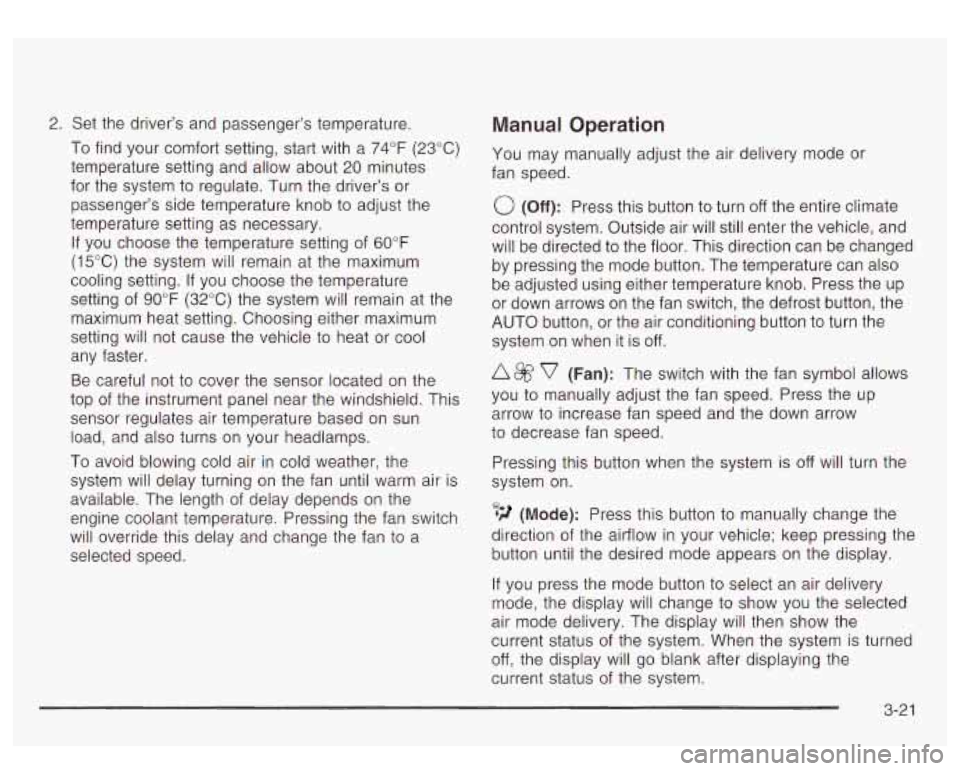
2. Set the driver’s and passenger’s temperature.
To find your comfort setting, start with a
74°F (23°C)
temperature setting and allow about
20 minutes
for the system to regulate. Turn the driver’s or
passenger’s side temperature knob
to adjust the
temperature setting as necessary.
If you choose the temperature setting of 60°F
(15°C) the system will remain at the maximum
cooling setting.
If you choose the temperature
setting of
90°F (32°C) the system will remain at the
maximum heat setting. Choosing either maximum
setting will not cause the vehicle to heat or cool
any faster.
Be careful not to cover the sensor located on the
top of the instrument panel near the windshield. This
sensor regulates air temperature based on sun
load, and also turns on your headlamps.
To avoid blowing cold air in cold weather, the
system will delay turning on the fan until warm air is
available. The length of delay depends on the
engine coolant temperature. Pressing the fan switch
will override this delay and change the fan to a
selected speed.
Manual Operation
You may manually adjust the air delivery mode or
fan speed.
0 (Off): Press this button to turn off the entire climate
control system. Outside air will still enter the vehicle, and
will be directed
to the floor. This direction can be changed
by pressing the mode button. The temperature can also
be adjusted using either temperature knob. Press the up
or down arrows on the fan switch, the defrost button, the
AUTO button, or the air conditioning button to turn the
system on when it is
off.
v (Fan): The switch with the fan symbol allows
you
to manually adjust the fan speed. Press the up
arrow
to increase fan speed and the down arrow
to decrease fan speed.
Pressing this button when the system
is off will turn the
system on.
% *d (Mode): Press this button to manually change the
direction of the airflow in your vehicle; keep pressing the
button until the desired mode appears on the display.
If you press the mode button to select an air delivery
mode, the display will change to show you the selected
air mode delivery. The display will then show the
current status of the system. When the system is turned
off, the display will go blank after displaying the
current status of the system.
3-21
Page 165 of 447
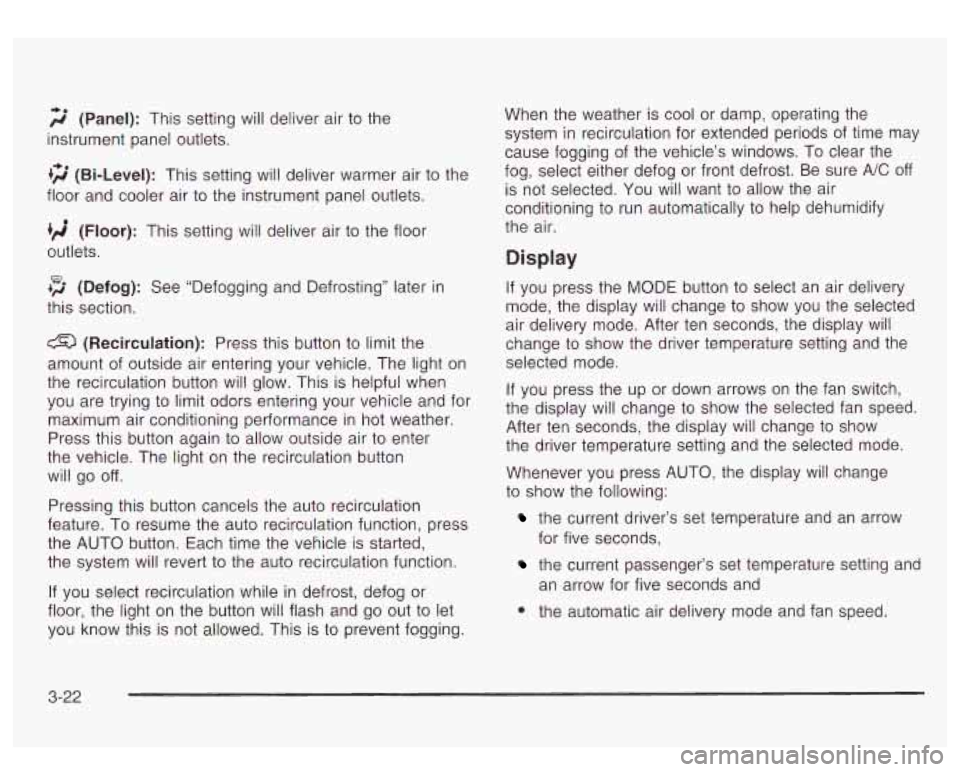
2 (Panel): This setting will deliver air to the
instrument panel outlets.
+2 (Bi-Level): This setting will deliver warmer air to the
floor and cooler air
to the instrument panel outlets.
(Floor): This setting will deliver air to the floor
outlets.
+3 (Defog): See “Defogging and Defrosting” later in
this section.
(Recirculation): Press this button to limit the
amount of outside air entering your vehicle. The light on
the recirculation button will glow. This is helpful when
you are trying
to limit odors entering your vehicle and for
maximum air conditioning performance in hot weather.
Press this button again to allow outside air to enter
the vehicle. The light on the recirculation button
will go
off.
Pressing this button cancels the auto recirculation
feature.
To resume the auto recirculation function, press
the AUTO button. Each time the vehicle is started,
the system will revert
to the auto recirculation function.
If you select recirculation while in defrost, defog or
floor, the light on the button will flash and go out
to let
you know this is not allowed. This is
to prevent fogging. When
the weather is cool or damp, operating the
system in recirculation for extended periods of time may
cause fogging of the vehicle’s windows.
To clear the
fog, select either defog or front defrost. Be sure
A/C off
is not selected. You will want to allow the air
conditioning
to run automatically to help dehumidify
the air.
Display
If you press the MODE button to select an air delivery
mode, the display will change to show you the selected
air delivery mode. After ten seconds, the display will
change to show the driver temperature setting and the
selected mode.
If you press the up or down arrows on the fan switch,
the display will change to show the selected fan speed.
After ten seconds, the display will change
to show
the driver temperature setting and the selected mode.
Whenever you press AUTO, the display will change
to show the following:
the current driver’s set temperature and an arrow
for five seconds,
the current passenger’s set temperature setting and
an arrow for five seconds and
0 the automatic air delivery mode and fan speed.
3-22
Page 166 of 447
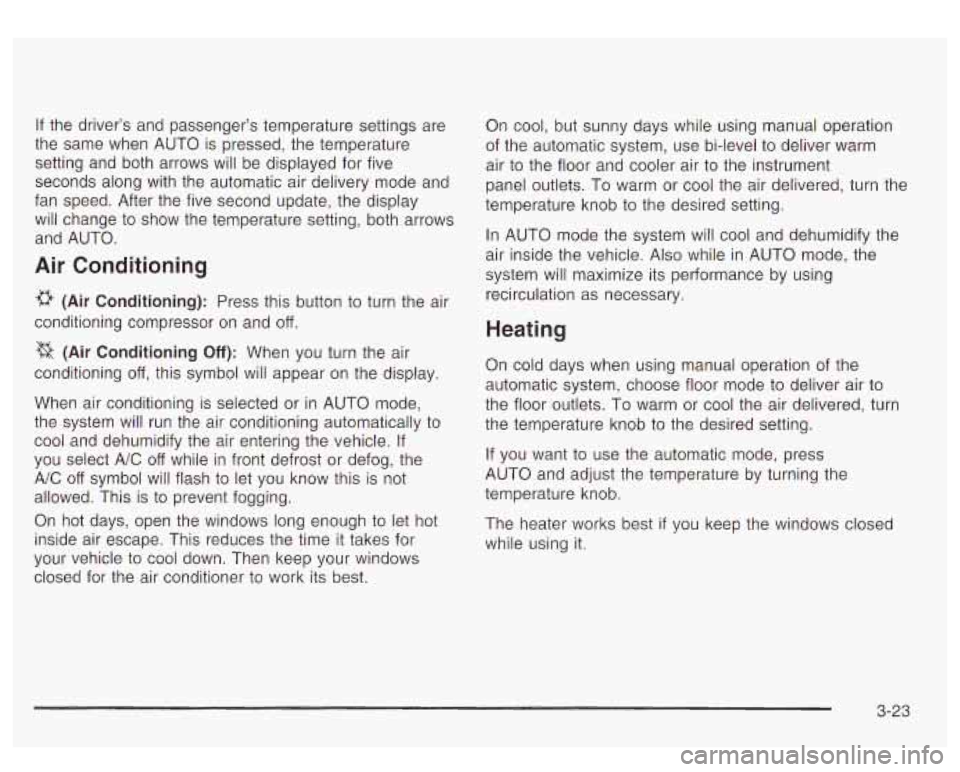
If the driver’s and passenger’s temperature settings are
the same when AUTO
is pressed, the temperature
setting and both arrows will be displayed for five
seconds along with the automatic air delivery mode and
fan speed. After the five second update, the display
will change to show the temperature setting, both arrows
and AUTO.
Air Conditioning
a (Air Conditioning): Press this button to turn the air
conditioning compressor on and
off.
% (Air Conditioning Off): When you turn the air
conditioning
off, this symbol will appear on the display.
When air conditioning is selected or in AUTO mode,
the system will run the air conditioning automatically to
cool and dehumidify the air entering the vehicle.
If
you select A/C off while in front defrost or defog, the
A/C off symbol will flash to let you know this is not
allowed. This is
to prevent fogging.
On hot days, open the windows long enough to let hot
inside air escape. This reduces the time it takes for
your vehicle to cool down. Then keep your windows
closed for the air conditioner to work its best. On
cool, but sunny days while using manual operation
of the automatic system, use bi-level
to deliver warm
air to the floor and cooler air to the instrument
panel outlets. To warm or cool the air delivered, turn the
temperature knob to the desired setting.
In AUTO mode the system will cool and dehumidify the
air inside the vehicle. Also while in AUTO mode, the
system will maximize its performance by using
recirculation as necessary.
Heating
On cold days when using manual operation of the
automatic system, choose floor mode to deliver air to
the floor outlets. To warm or cool the air delivered, turn
the temperature knob to the desired setting.
If you want to use the automatic mode, press
AUTO and adjust the temperature by turning the
temperature knob.
The heater works best
if you keep the windows closed
while using it.
3-23
Page 167 of 447
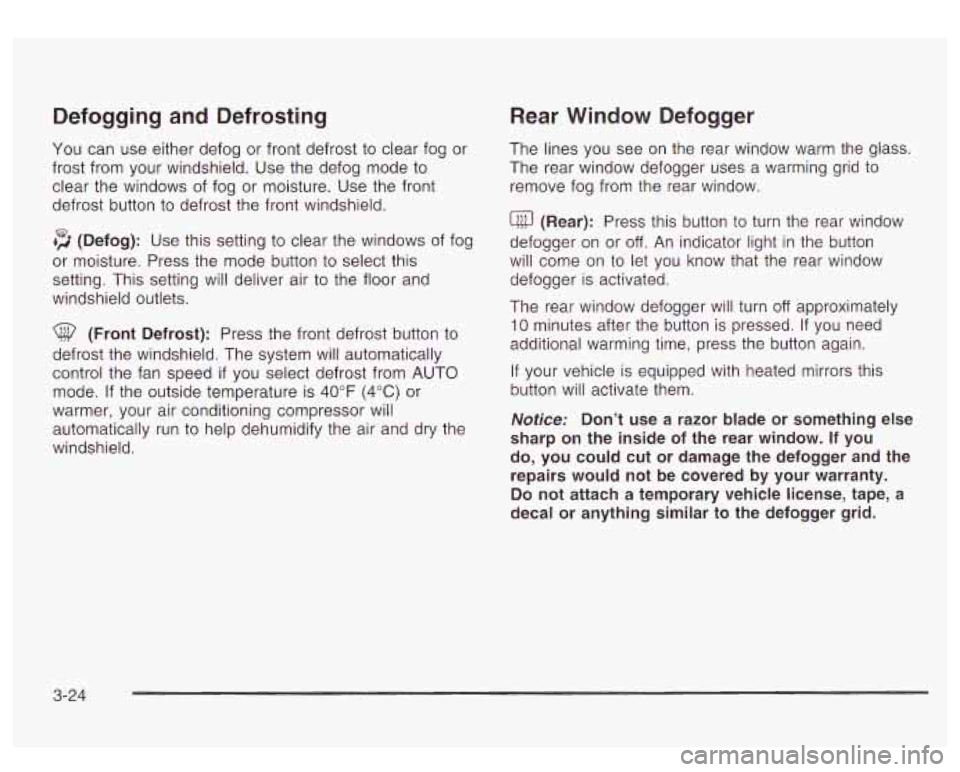
Defogging and Defrosting
You can use either defog or front defrost to clear fog or
frost from your windshield. Use the defog mode
to
clear the windows of fog or moisture. Use the front
defrost button to defrost the front windshield.
(Defog): Use this setting to clear the windows of fog
or moisture. Press the mode button to select this
setting. This setting will deliver air
to the floor and
windshield outlets.
@ (Front Defrost): Press the front defrost button to
defrost the windshield. The system will automatically
control the fan speed
if you select defrost from AUTO
mode. If the outside temperature is
40°F (4°C) or
warmer, your air conditioning compressor will
automatically run
to help dehumidify the air and dry the
windshield.
Rear Window Defogger
The lines you see on the rear window warm the glass.
The rear window defogger uses a warming grid
to
remove fog from the rear window.
(Rear): Press this button to turn the rear window
defogger on or
off. An indicator light in the button
will come on to let you know that the rear window
defogger is activated.
The rear window defogger will turn
off approximately
10 minutes after the button is pressed. If you need
additional warming time, press the button again.
If your vehicle is equipped with heated mirrors this
button will activate them.
Notice: Don’t use a razor blade or something else
sharp on the inside of the rear window. If you
do, you could cut or damage the defogger and the
repairs would not be covered by your warranty.
Do not attach a temporary vehicle license, tape, a
decal or anything similar to the defogger grid.
3-24
Page 168 of 447
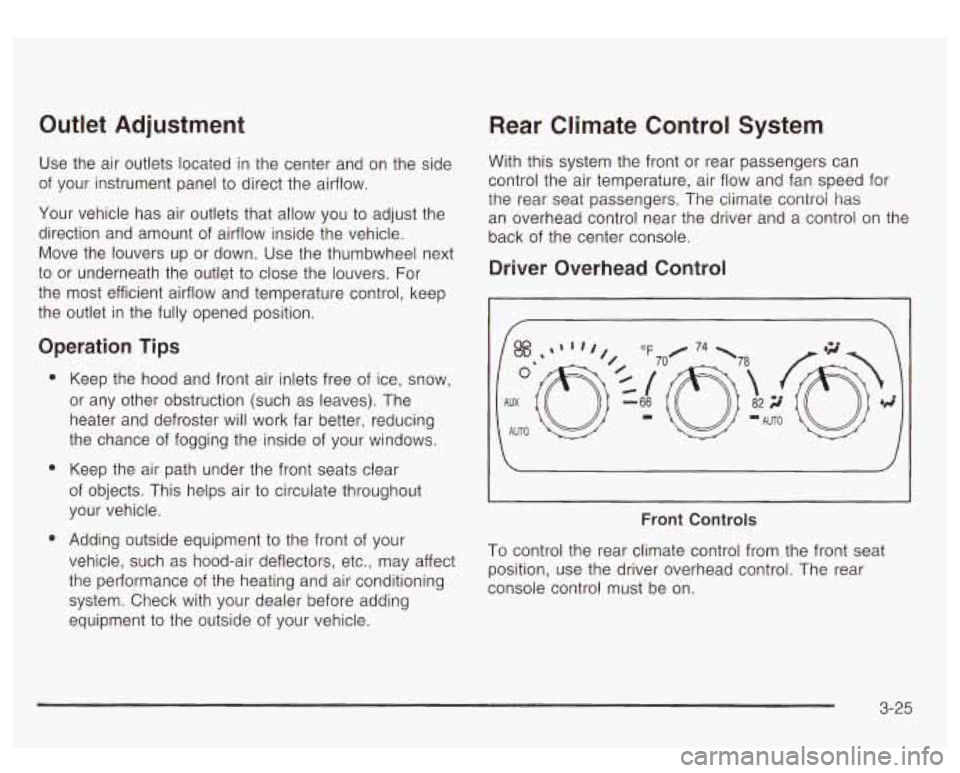
Outlet Adjustment
Use the air outlets located in the center and on the side
of your instrument panel to direct the airflow.
Your vehicle has air outlets that allow you to adjust the
direction and amount of airflow inside the vehicle.
Move the louvers up or down. Use the thumbwheel next
to or underneath the outlet
to close the louvers. For
the most efficient airflow and temperature control, keep
the outlet in the fully opened position.
Operation Tips
e
e
Keep the hood and front air inlets free of ice, snow,
or any other obstruction (such as leaves). The
heater and defroster will work far better, reducing
the chance of fogging the inside of your windows.
Keep the air path under the front seats clear
of objects. This helps air to circulate throughout
your vehicle.
Adding outside equipment
to the front of your
vehicle, such as hood-air deflectors, etc., may affect
the performance of the heating and air conditioning
system. Check with your dealer before adding
equipment to the outside of your vehicle.
Rear Climate Control System
With this system the front or rear passengers can
control the air temperature, air flow and fan speed for
the rear seat passengers. The climate control has
an overhead control near the driver and a control on the
back of the center console.
Driver Overhead Control
I/
I
Front Controls
To control the rear climate control from the front seat
position, use the driver overhead control. The rear
console control must be on.
3-25
Page 169 of 447
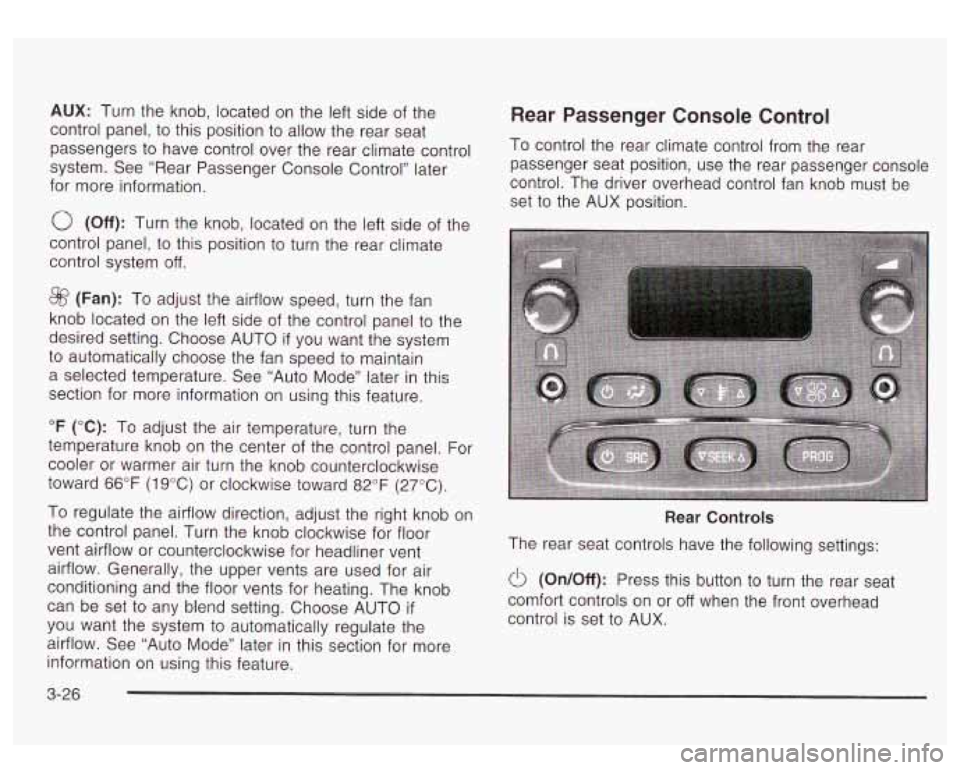
AUX: Turn the knob, located on the left side of the
control panel, to this position
to allow the rear seat
passengers
to have control over the rear climate control
system. See “Rear Passenger Console Control’’ later
for more information.
0 (Off): Turn the knob, located on the left side of the
control panel,
to this position to turn the rear climate
control system
off.
@ (Fan): To adjust the airflow speed, turn the fan
knob located on the left side of the control panel
to the
desired setting. Choose AUTO
if you want the system
to automatically choose the fan speed to maintain
a selected temperature. See “Auto Mode” later in this
section for more information on using this feature.
“F (“C): To adjust the air temperature, turn the
temperature knob on the center of the control panel. For
cooler or warmer air turn the knob counterclockwise
toward
66°F (1 9°C) or clockwise toward 82°F (27°C).
To regulate the airflow direction, adjust the right knob on
the control panel. Turn the knob clockwise for floor
vent airflow or counterclockwise for headliner vent
airflow. Generally, the upper vents are used for air
conditioning and the floor vents for heating. The knob
can be set
to any blend setting. Choose AUTO if
you want the system to automatically regulate the
airflow. See “Auto Mode” later in this section for more
information on using this feature.
Rear Passenger Console Control
To control the rear climate control from the rear
passenger seat position, use the rear passenger console
control. The driver overhead control fan knob must be
set
to the AUX position.
Rear Controls
The rear seat controls have the following settings:
0 (OnIOff): Press this button to turn the rear seat
Comfort controls on or
off when the front overhead
control is set
to AUX.
3-26